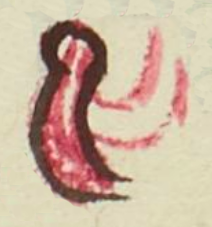Tecpin (MH576v)
This black-line drawing of the simplex glyph for the personal name Tecpin (“Flea,” attested here as a man’s name) shows a profile view of a full-bodied flea (tecpin). It has a vague head and curving body with two visible legs. The body and head are outlined in black and colored with red. The legs are just marked with red, no black.
Stephanie Wood
It might seem somewhat surprising to find someone named "Flea," but it could have been a reference to the person's diminutive size--or even the opposite, the way today someone skinny might be called "Gordo" in a playful way.
Diagrams of flea body parts vary. Some show three pairs of legs, some show fewer. Most diagrams show mouth parts that hang down or protrude, and given the usual Nahua attention to detail with insects, it is surprising that these protrusions and the claws on the legs are not showing here. This suggests some haste in drawing this glyph or little familiarity with fleas on the part of the tlacuilo.
The term tecpin, ending in -in, is often written without an absolutive, perhaps because many animal names end in -in (e.g. michin, fish). And Michel Launey suggested the word for flea does not have an absolutive form. But tecpintli has been reconstructed by various linguists, and John Sullivan and the IDIEZ group suggest tecpimitl as the full term. See our Online Nahuatl Dictionary.
Stephanie Wood
peo. tecpin
Pedro Tecpin
Stephanie Wood
1560
Jeff Haskett-Wood
insects, insectos, fleas, pulgas

tecpin or tecpim(itl), a flea, https://nahuatl.wired-humanities.org/content/tecpin
La Pulga
Stephanie Wood
Matrícula de Huexotzinco, folio 576v, https://www.loc.gov/resource/gdcwdl.wdl_15282/?sp=232&st=image
This manuscript is hosted by the Library of Congress and the World Digital Library; used here with the Creative Commons, “Attribution-NonCommercial-ShareAlike 3.0 License” (CC-BY-NC-SAq 3.0).







